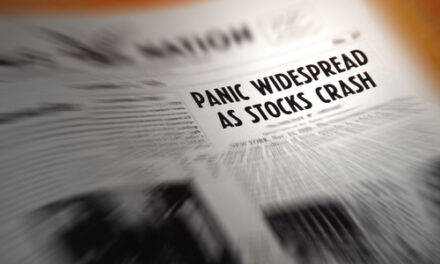Stocks sold off on Monday. The S&P 500 fell as much as 2.6% before rebounding into the close.
And so the mainstream media pundits needed to fill the air with reasons why.
CNBC came up with five:
-
Investors fear a contagion sweeping financial markets from the troubled China property market. Hong Kong equities saw a big sell-off during the Asia trading session on Monday. The benchmark Hang Seng Index plunged 4% with embattled developer China Evergrande Group on the brink of default.
-
The Federal Reserve begins a two-day meeting Tuesday and investors are worried the central bank will signal it’s ready to start pulling away monetary stimulus amid surging inflation and improvement in the job market.
-
Because of the delta variant, Covid cases remain at January levels as colder weather approaches in North America.
-
September has the worst track record of any month, averaging a 0.4% decline, according to the Stock Trader’s Almanac. History shows the selling tends to pick up in the back half of the month.
-
Investors are also concerned about brinkmanship in D.C. as the deadline to raise the debt ceiling approaches. Congress returned to Washington from recess rushing to pass funding bills to avoid a government shutdown.
All things I’m sure you’ve heard about in the news, or know from simply being familiar with markets.
It’s always simple to find a narrative that explains why stocks are going down. However, these events are more often used to instill panic in financial news viewers than actually explain market conditions.
Is the Market Sell-off Here to Stay?
Let’s look at each of these reasons in close detail, and figure out whether these threats to the market hold any water…
-
China has been working through crises for most of the past year.
Evergrande owns more than 1,300 real estate projects in over 280 cities in China and is responsible for millions of jobs in construction and property management. The company seems to have debts of about $300 billion.
This is a problem for Asian bond and equity markets and China’s economic growth. As China’s government addresses the problem, they may work to cheapen exports and that could dramatically reduce inflationary pressures in the U.S.
This China real estate crisis is the headline item today, but in my view it doesn’t have staying power in the U.S. stock market. If anything, a reduction in inflationary pressures would cool bubble concerns and could even stave off the Fed’s tapering.
-
The Fed isn’t going to do anything dramatic this year. Officials realize politicians have created a precarious position with the debt ceiling crisis, the budget standoff, and demands for massive spending.
If the Fed tightens (stops buying bonds and/or raises interest rates), it’s unlikely Powell will be reappointed to a second term as Chairman.
Look for supportive statements from the Fed until Powell’s fate is announced.
-
Covid is becoming part of the new normal. The CNN Back-to-Normal Index — which compares post-pandemic job data, market stats, and consumer spending and behavior to pre-pandemic numbers — stands at 89%. It’s been in a narrow range around 90% since May. The economy is likely to remain range-bound until the issues in Washington are resolved.

Source: CNN
(Click here to view larger image.)
-
September’s seasonal tendency is well known. But it’s due to just a few bad years in the stock market in 1974 (-12%), 1931 (-30.5%), and 1933 (-12.3%) weighing down the long-term average of –1.2%. When these large moves are excluded, September is an average month.
-
The brinkmanship in D.C. is also part of the new normal. The debt ceiling has been a political struggle for decades. Budget battles occur almost every year. The headline-grabbing $3.5 trillion spending bill will be subject to negotiations. It’s the same thing we see every year in Congress.
Deadlock in Washington hasn’t been the death knell for markets in the past, and I doubt it will be this time, either.
There are certainly reasons to be concerned about China, the Fed, Covid, and Congress.
But the companies in the S&P 500 are reporting record-high profit margins. That’s bullish…
Investors have trillions of dollars to put to work in the stock market. That’s bullish…
And the first 5% pullback in over 10 months is likely to be viewed as a buying opportunity by investors with cash in their accounts.
For now, this looks like a buying opportunity to me, as well.
Regards,

Michael Carr
Editor, One Trade
Chart of the Day:
As Goes This Stock, so
Goes the Market…

(Click here to view larger image.)
Today let’s take a look at Apple (Nasdaq: AAPL) in the wake of yesterday’s sell-off…
As I’ve mentioned before, AAPL stock is a strong barometer of the overall direction of the S&P 500. It alone makes up nearly 6% of the index.
So when AAPL makes a move, it’s likely that the broad market will move right along with it. And by studying the AAPL chart, we can get another view of the broad market’s risk appetite.
After briefly breaking out of an upside wedge pattern a couple weeks back, AAPL got smacked right back down into the pattern to retest the rising support yet again. The breakout turned out to be a fakeout.
Then came last Friday. AAPL broke down through the pattern this time, and opened on Monday below its long-term horizontal support at about $144. It’s set to open right on that horizontal support today.
If AAPL can hold steady and mount a rally in today’s trading, I can see it chopping around for the next week or so until the market decides what it wants to do. In my view, AAPL and the broad market will make a run at new highs before we can blink.
But if AAPL does lose its current support, it could fall all the way down to $137. As Mike said today, I would see that as a buying opportunity.
Regards,

Mike Merson
Managing Editor, True Options Masters










